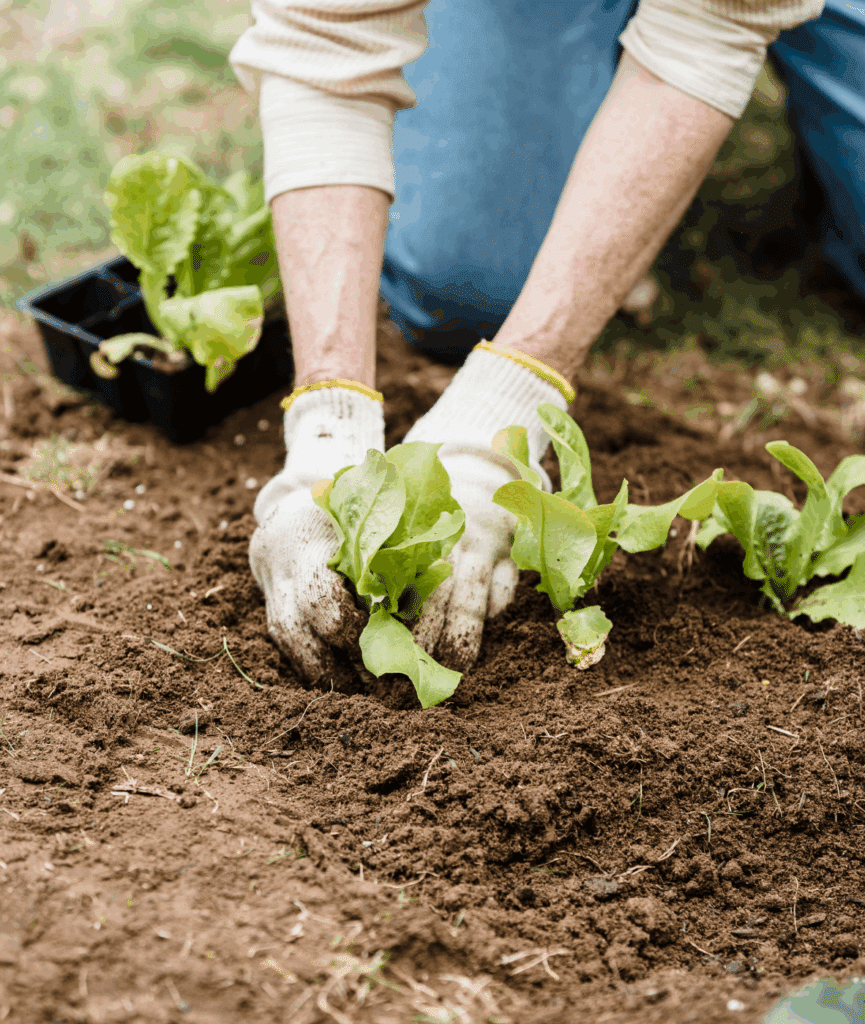Using Sensory Gardens and Nature-Based Mindfulness for Stress Reduction

When stress isn’t properly managed, it can lead to a variety of health issues, including anxiety, depression, and burnout.1 High levels of stress may also be a contributing factor to high blood pressure, which increases the risk of cardiovascular disease or stroke.2
However, there’s a growing amount of research that suggests spending time in nature and engaging in gardening activities can reduce stress and improve our well-being.3 If you’re unsure how to get started, this guide looks into the healing power of nature and the benefits of sensory gardens. It also considers how nature-based mindfulness techniques could help to support mental health, improve emotional regulation, and reduce stress by discussing:
What sensory gardens are- How sensory gardens help mental health
- Mindfulness through sensory gardens
- Ideas for nature-based mindfulness activities to reduce stress and anxiety
- Sensory garden design
- How Mission Connection can help and support you

What Are Sensory Gardens?
Sensory gardens are carefully designed and built outdoor spaces that aim to engage and stimulate the five senses, which include:
- Sight
- Sound
- Taste
- Touch
- Smell
By combining elements that awaken and engage these senses, sensory gardens create a rich and immersive experience. How sensory gardens help mental health involves how they make use of different textures and stimuli, such as:
- Tactile areas, such as areas with natural textures like bark, grass, or soft leaves
- Stimulating scents, such as those provided by herb gardens
- Vibrant floral displays
- Interesting soundscapes, like running water features or hanging wind chimes
- Edible plants, like herbs, berries, or certain flowers
- Areas for quiet reflection and solitude
By serving as a quiet, therapeutic, yet engaging space, sensory gardens allow people to tune into the present moment and regulate emotions in non-confrontational ways.
How Sensory Gardens Support Mental Health
Nature therapy for emotional regulation may be especially useful for people who struggle with stress, burnout, anger issues, or overwhelm. For instance, activities such as mindful walking in a garden have been shown to enhance emotional regulation, increase resilience, and improve cognitive function.5,6
However, people with more complex mental health needs, such as those resulting from trauma, may also benefit from nature-based therapy. For example, studies show that garden therapy for mental clarity allows people to process difficult emotions in ways that calm the nervous system instead of continuing to activate it.7
Who Can Benefit from Sensory and Mindfulness Gardens?
Adults experiencing stress, anxiety, or burnout 8- Children with sensory processing difficulties or ADHD 9
- Neurodivergent people10
- Elderly residents in care settings11
Additionally, sensory gardens can be designed to be inclusive of and accessible to all people, including those who have mobility issues or disabilities.
How someone benefits from a sensory garden may depend on what their specific needs are. For example, some may enjoy simply sitting still, engaging in structured mindfulness activities, or actively tending to the garden area. However, the physical act of gardening itself may produce the most benefits for well-being, as studies show that it can boost mood and confidence, as well as reduce stress. These advantages may come from the sense of contributing something meaningful to the environment and witnessing visible growth.
Mindfulness Through Sensory Gardens
Mindfulness is a type of mental focus that allows you to focus on the present moment and tune out negative and intrusive thoughts. In other words, instead of allowing a negativity spiral to kick in, you gently bring your attention to the here and now, reducing stress.
By harnessing the power of mindfulness, you can create space between yourself and your thoughts and learn to accept your feelings without judgment or rumination. In fact, mindfulness has been proven to help manage mental health conditions, including depression and anxiety.12
Gardens can be designed to maximize the benefits of mindfulness by tapping into the five senses. For instance, the 5-4-3-2-1 technique works best when there are elements that require us to focus on:
- Five things we can see
- Four we can touch
- Three we can hear
- Two things we can smell
- One we can touch
Each of these steps allows us to deeply tune into our surroundings and connect with nature in meaningful ways. Additionally, even physical tasks like weeding remove us from feelings of anxiety and stress by pulling focus to the present moment.
Nature-Based Mindfulness Activities to Try
You don’t need to have an expansive garden to reap the benefits of sensory gardening and mindfulness; you might just need some ideas about how to increase your connection with nature. For instance, mindfulness exercises in nature gardens could include:
- Sound meditation using leaves rustling in the wind or a wind chime
- Taking mindful walks, paying special attention to textures underfoot, the sounds of birds chirping, or the different scents around you
- Mindful eating of produce from the garden, for example, berries or herbs
- Nature-based art activities such as mindful collaging with leaves or coloring
- Mindfulness-based exercises, such as outdoor yoga or tai chi
- Grounding exercises, such as using textured stones or the 5-4-3-2-1 technique
- Practical gardening activities to enhance wellbeing, such as mindfulness gardening for anxiety relief
Further, these nature-based mindfulness activities can be enjoyed alone or as part of a group. You could also take a more freestyle approach, allowing the healing benefits of sensory gardens to be felt by simply wandering around and exploring at your leisure.
Designing a Calming Sensory Garden for Relaxation
Regardless of whether you’re a professional who is considering creating a sensory garden for clients or someone who wants to design one for personal use, there are a few key elements to consider. Designing a calming and relaxing garden space for emotional wellness requires careful planning and preparation, so aim to…
- Find a suitable space for your sensory garden, for example, a shared community space, a private space, or a garden area in a residential home for the elderly
- Consider the garden’s purpose. For instance, is it for relaxation, a safe space for reflection, therapeutic group activities, and so on
- Think carefully about practicalities such as your budget or any planning permission that may be required
- Design the garden using universal design principles to ensure it is accessible. For example, think about whether wide paths, ramps, or safe spaces are needed
- Consider interactive elements and how to encourage exploration, like including winding paths, hidden features, hedge mazes, and so on
- Source relevant items, including plants, soil, garden features, or any special tools you might need
- Ensure you have an adequate number of helpers to build, plant, and maintain the garden
When choosing what to plant in your sensory garden, you may want to consider the following elements:
Textures
Try to include an array of textures in your sensory garden. For example, when designing a sensory garden for relaxation, plant ornamental grasses or weeping willow trees that gently rustle and sway in the wind. Spiky succulents and soft velvety plants like Lamb’s Ear can also give opposing sensory experiences when stroked or touched, which can help to interest and engage visitors to the garden.
Fragrances
Herbs and flowers that have strong scents are a good option in sensory gardens, as they can be used in aromatherapy exercises. These include ones like lavender, rosemary, mint, and thyme.
Colors
Different colors can have different effects on our brains and mood.13 Therefore, add splashes of color between the greens of the garden by planting vibrant flowers such as sunflowers or azaleas. Some plants can also provide a fun, tropical vibe – think birds of paradise, banana trees, dwarf palms, or amaryllis.
Additionally, consider zoning the garden for different purposes, with some areas featuring bright, energizing orange and red flowers and others designed to have a more muted or calming energy.
Insects and Wildlife
A sensory garden is not only a place to relax and reflect, it’s also a miniature ecosystem in its own right. Biodiversity in the garden is essential in creating a healthier and more resilient natural environment.14 Insect and wildlife visitors play a key role in supporting your garden’s well-being, from pollination to natural pest control.
A diverse insect population could also provide audio and visual stimulation (think the buzzing of bees, the gentle chirping of crickets, or the intricate patterns on a butterfly’s wings). You could attract pollinators such as bees and butterflies to your sensory garden by planting buddleia, heather, and lavender.
Edible Plants
Planting edible plants adds a tasting component to a sensory garden. Plus, the sowing, nurturing, and harvesting of herbs, fruits, or edible flowers offers an interactive and mindful activity for users of the garden to enjoy.
Get Support With Mission Connection Today
At Mission Connection, our trained therapists understand the power of nature-based mindfulness activities. We can incorporate such activities as part of a holistic treatment plan to support you on your healing journey.
We also tailor our treatment plans to each person’s individual needs and lifestyle, providing outpatient, inpatient, and telehealth services to accommodate your schedule. Plus, if you’re curious about mindfulness therapy or simply want to chat about the benefits of sensory gardens for mental health, our team is always available.
We’re here to listen with empathy and support, so reach out whenever you’re ready to start your mental well-being journey.

References
- Khan, S., Khan, R. A., & Khan, et al. (n.d.). Chronic stress leads to anxiety and depression. In Annals of Psychiatry and Mental Health (p. 1091). https://www.jscimedcentral.com/public/assets/articles/psychiatry-5-1091.pdf
- American Heart Association. (n.d.). Stress and heart health. https://www.heart.org/en/health-topics/stress/stress-and-heart-health
- Van Den Berg, A. E., & Custers, M. H. (2010). Gardening promotes neuroendocrine and affective restoration from stress. Journal of Health Psychology, 16(1), 3–11. https://doi.org/10.1177/1359105310365577
- Barton, J., & Rogerson, M. (2017). The importance of greenspace for mental health. BJPsych International, 14(4), 79–81. https://doi.org/10.1192/s2056474000002051
- Koay, W. I., & Dillon, D. (2020). Community gardening: Stress, well-being, and resilience potentials. International Journal of Environmental Research and Public Health, 17(18), 6740. https://doi.org/10.3390/ijerph17186740
- Burdick, A. A. V., & Camhi, S. M. (2024). The effects of a guided mindful walk on mental health in university students. International Journal of Exercise Science, 17(5). https://doi.org/10.70252/xxrm5481
- Joschko, L., Pálsdóttir, A. M., Grahn, P., & Hinse, M. (2023). Nature-based therapy in individuals with mental health disorders, with a focus on mental well-being and connectedness to nature—A pilot study. International Journal of Environmental Research and Public Health, 20(3), 2167. https://doi.org/10.3390/ijerph20032167
- Fortes, P. P., Santos-Ribeiro, S. D., De Salles Andrade, J. B., Moreira-De-Oliveira, M. E., De Abreu-Cervone, F., De Faro, L. F. T., De Melo-Fadel, B. T. M., De Menezes, G. B., & Fontenelle, L. F. (2024). Mindfulness interventions and quality of life in anxiety-related disorders: A systematic review and meta-analysis. Journal of Affective Disorders. https://doi.org/10.1016/j.jad.2024.12.103
- Kuo, F. E., & Taylor, A. F. (2004). A potential natural treatment for attention-deficit/hyperactivity disorder: Evidence from a national study. American Journal of Public Health, 94(9), 1580–1586. https://doi.org/10.2105/ajph.94.9.1580
- Fan, M. S. N., Li, W. H. C., Ho, L. L. K., Phiri, L., & Choi, K. C. (2023). Nature-based interventions for autistic children. JAMA Network Open, 6(12), e2346715. https://doi.org/10.1001/jamanetworkopen.2023.46715
- Catissi, G., Gouveia, G., Savieto, R. M., Silva, C. P. R., De Almeida, R. S., Borba, G. B., Rosario, K. A., & Leão, E. R. (2024). Nature-based interventions targeting elderly people’s health and well-being: An evidence map. International Journal of Environmental Research and Public Health, 21(1), 112. https://doi.org/10.3390/ijerph21010112
- Keng, S., Smoski, M. J., & Robins, C. J. (2011). Effects of mindfulness on psychological health: A review of empirical studies. Clinical Psychology Review, 31(6), 1041–1056. https://doi.org/10.1016/j.cpr.2011.04.006
- BBC Future. (n.d.). How colours affect the way you think. https://www.bbc.com/future/article/20150402-the-power-of-colour
- Miller, J. R. (2005). Biodiversity conservation and the extinction of experience. Trends in Ecology & Evolution, 20(8), 430–434. https://doi.org/10.1016/j.tree.2005.05.013
